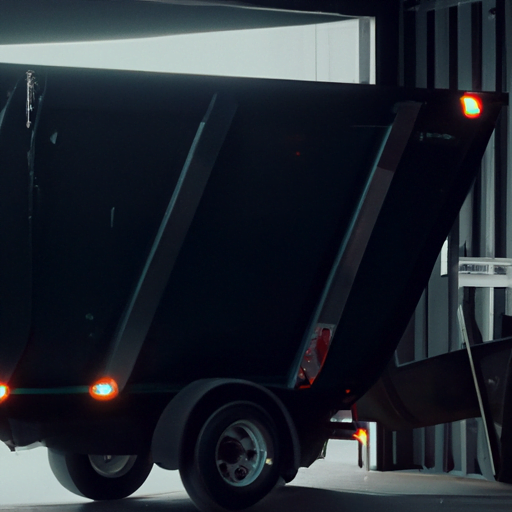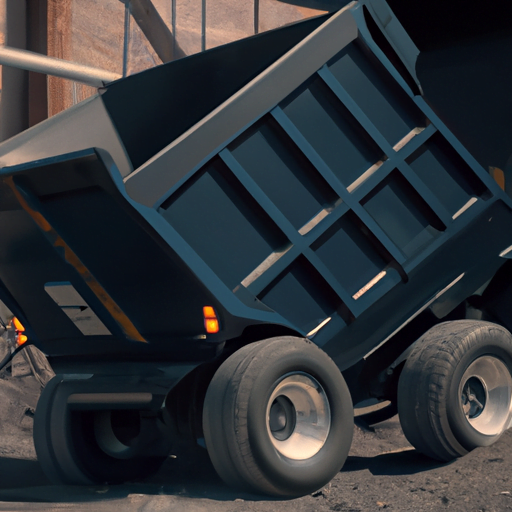-
Table of Contents
Introduction
“Properly Loading Your Dump Trailer” is a comprehensive guide that provides clear, step-by-step instructions on how to safely and efficiently load your dump trailer. This guide covers key aspects such as weight distribution, loading procedure, securing the load, and verifying legal requirements. Ensuring proper technique not only guarantees safety but also extends the life of your dump trailer by avoiding damage due to overloading or improper balancing. Understanding these principles can prove indispensable whether you’re new to operating a dump trailer or an experienced user looking for a refresher course in best practices.
Essential Safety Measures for Properly Loading Dump Trailers Near Me
Loading a dump trailer is not just about throwing in everything you need to haul away. It’s an art that requires calculated moves, diligence and understanding of the essential safety measures. The importance of properly loading your dump trailer cannot be overstated because it could make a big difference in terms of efficiency, as well as prevent accidents or damage to equipment which can result from improper handling.
First off, it’s necessary that one familiarizes themselves with their specific dump trailer capacity. Each model will have its own limit for weight and volume; overloading may cause issues such as tire blowouts or an inability to properly unload when you arrive at your destination. Hence, check the specifications outlined by the manufacturer meticulously before starting any hauling process.
Once all this information has been reviewed and understood, pre-planning comes into play: what items are going where? This might seem trivial but believe me – it makes a whole world of difference! Here’s why: if heavier materials are placed towards the rear end rather than being evenly distributed throughout the entire bed space or placed farthest first (from backside), there would be a high possibility for tipping while unloading.
On top of that, they should place larger items on the bottom whereas lighter ones should rest atop these bigger pieces creating some type of ladder system – essentially tiered structure based on size (and sometimes fragility). This helps create stability within mix thus reducing chance shifts occurring during transportation.
But here’s something even more crucial – balance matters! Distribute load equally across both sides trailer so one side isn’t weighed down disproportionately compared other also helps maintain balanced distribution keeping vehicle stable throughout journey preventing mishaps like overturning due imbalance weight carried either directions horizontally vertically along axis rotation wheels chassis base truck frame itself .
While packing up your cargo remember not to pile too high especially closer front because doing can affect visibility driver leading potential accidents road moreover higher means greater risk losing control also possible wind resistance may pose problem during journey.
So, you’ve taken great care in loading up your dump trailer. What’s next? Strapping it down securely! It is not enough to just load a trailer – one must secure the load with reliable straps or tarps so nothing can shift around or fly out while driving. This keeps items inside safe from damage and prevents causing any potential dangers for other road users.
Finally, constant checks are a part of maintaining safety measures throughout this process. Before taking off on your journey, take time to inspect all aspects of your loaded trailer for any possible issues that need addressing and continue to do so at regular intervals during transportation.
And that’s about it! The steps outlined above may seem tedious at first but they actually ensure both safety and efficiency when hauling away material using dump trailers. Yes, properly loading a dump trailer does require some effort but considering the fact that such preventive actions will save you from countless potential hassles – it’s definitely worth investing time into doing things right way!
Always remember: Safety isn’t expensive; it’s priceless! Happy hauling everyone!
Step-by-Step Guide on How to Properly Load Local Dump Trailers
If you’ve ever thought of taking on a major project that produces huge quantity of waste or other materials, it’s very likely you have considered using local dump trailers. These are sizable trailers meant for hauling and dumping large amounts of debris, making them an immensely helpful tool to appropriately dispose waste material from home renovations, landscaping jobs and so forth. However, loading these robust vehicles is not as straightforward as one might assume which makes it important to understand the step-by-step guide on how to properly load your local dump trailer.
Let’s kick this off by talking about safety first. It’s imperative that when loading the trailer that you wear appropriate gear—protective gloves, sturdy boots and even a hard hat if overhead hazards enter into play. This will keep potential injuries at bay during the job.
The second key aspect involves understanding weight distribution for optimal balance while moving down any type of terrain or slope – paved roads included. The goal here is to create equability all around in order to prevent tipping over during transport. To achieve this equilibrium start putting heavier objects right at the center then evenly distribute others towards outward edges following a pyramid structure pattern with lighter items piled atop denser ones at base level.
Next up we need to talk about avoiding overcrowding which can lead into violation territory because safety regulations stipulate specific weight limits per axle, commonly referred as Gross Vehicle Weight Rating (GVWR). So avoiding going beyond GVWR plays pivotal role not only keeping everyone safe but also ensuring compliance with law enforcement entities who routinely carry out roadside checks across many territories nationwide.
Another critical thing worth noting before we proceed further: avoid mixing different types of rubbish unless specified as acceptable by relevant authority agencies mainly due environmental concerns apart sanitary issues arising after mixed loads get dumped together; think corrosive elements reacting undesirably within landfill sites! Keep like-minded trash grouped together where possible benefiting recycling efforts thereby minimizing overall environmental impact concurrently.
After thoroughly checking everything listed above move onto securing load effectively which can be achieved with help from sturdy webbing straps, chains or tarps to prevent sudden shifts or spills during travel. Remember, unsecured loads not only pose dangerous risks on the road but also infract transportation laws resulting into hefty fines.
Lastly – and perhaps most irksomely – thoroughly clean your trailer after every use! This might sound like a no-brainer, but an alarming number of users tend to neglect this vital maintenance step insofar they take it for granted local dump trailers are inherently dirty objects given their primary purpose. However over time grime build-up may lead towards decreased performance due haulage weight increases associated alongside long-term damage potential looming large if corrosive elements get enough time eat away crucial structural components within these metallic workhorses.
In conclusion-using a dump trailer doesn’t have to feel like you’re taking advanced mathematics examinations; nor should it become source for headaches caused by avoidable traffic violations. By keeping safety first echeloning down through optimal loading techniques followed by regimented cleaning schedule ensures maximum utility derived out such effective tool letting your projects run smoother while staying green respecting environment we all share alike.
Mastering the Art of Safely and Effectively Loading Your Dump Trailer
Dump trailers provide a handy means to transport heavy or bulky items for work projects, cleanouts, and much more. However, properly loading your dump trailer is essential not only to maintain its longevity but also to ensure the safety of everyone involved in its operation. Mastering the art of safely and effectively loading your dump trailer can seem complex initially, but with careful consideration and adherence to best practices, it becomes an easily conquerable task.
Before we dive into actionable strategies on how you can better load your dump trailer, it’s vital first to understand why this topic holds such importance. A poorly loaded dump trailer could lead us down a path fraught with hazards—tire blowouts because of disproportionate weight distribution or even tipping issues which might result in serious accidents while driving are some notable examples.
Now that we’ve established why learning effective methods of loading our dump trailers is necessary let’s delve into practical tips that one should bear in mind during this process. First off, distributing weight evenly across the floor space is paramount. This principle applies whether you’re hauling soil for landscaping purposes or emptying a house full of old furniture—it doesn’t matter what you’re moving; balanced cargo makes for safer transportation.
To achieve this equilibrium point when loading your materials into the bin area of the trailer remember always start at the front closest to where it attaches onto your vehicle progressively working back towards the rear end by spreading material side-to-side as well across axle lines simultaneously maintaining symmetry throughout hence ensuring overall stability while transit besides prolonging life expectancy tires through prevention unnecessary wear tear caused improper balance loads.
As important as achieving proper weight distribution is taking care not to overload beyond capacity another critical factor account whenever using equipment like ours here today each model has specific maximum allowable total measure usually described terms Gross Vehicle Weight Rating or GVWR short often stamped right there visible somewhere within confines unit itself so be sure take note heed guidelines provided manufacturer prevent structural damage potential safety issues down line moreover staying within prescribed limits also helps avoid hefty fines may incurred violation local transport regulations.
Beyond these basic tips, there’s a lot to consider when it comes to securing your load effectively. For loose items like gravel or soil, this might involve using a tarp or cover to prevent the material from being blown about while in motion. When hauling more substantial items—like furniture or construction materials—it’s crucial to use straps, chains, and other tools at your disposal to secure each piece of cargo individually and the entire load as a whole. This additional effort will reduce shifting during transit that could destabilize your trailer and even lead to disastrous accidents.
In conclusion, loading a dump trailer doesn’t have be daunting task filled with uncertainty; armed right knowledge approach can master art safely efficiently adding value operation overall preserving its longevity course above all else ensuring safety everyone involved by being mindful essential factors such weight distribution maximum capacity proper securing loads every time ensure successful transportation experience from point A B setting self up success down road pun intended happy safe hauling!
Q&A
- Q: What is the first step in properly loading a dump trailer?
A: The first step in properly loading a dump trailer is to ensure that your vehicle has enough towing capacity to handle the weight of the loaded trailer. Also, make sure the trailer is hooked up correctly and securely to your tow vehicle. -
Q: How should materials be arranged inside the dump trailer?
A: Materials should be evenly distributed over the entire length and width of your dump bed with heavier items at bottom; this helps maintain stability when you’re on road and makes it easier for dumping process. -
Q: Is there any precaution to take while loading a dump trailer?
A: Yes, never overload a dump trailer beyond its carrying capacity as it can cause severe damage to both your vehicle and the equipment itself, plus it’s unsafe. Also, ensure all loads are adequately secured before transport to prevent movement during transit that could lead to instability or accidents.
Conclusion
After careful consideration of the steps involved, it can be concluded that properly loading a dump trailer involves processes designed to ensure safety and efficiency. This includes evenly distributing weight throughout the trailer, not surpassing its maximum capacity, securing items appropriately to avoid shifting during transportation and checking all equipment before use. Moreover, understanding the specific guidelines provided by manufacturers is critical for optimal functionality and longevity of your dump trailer. In conclusion, when these rules are observed consistently, they facilitate smooth operations while preventing accidents or damages to your dump trailer.


